This checkin to GCAB935 Bartolotti House reflects a geocaching.com log entry. See more of Dan's cache logs.
Easy to spot, but I had to wait a while to be able to stealthily retrieve the cache. TFTC!
Dan Q
This checkin to GCAB935 Bartolotti House reflects a geocaching.com log entry. See more of Dan's cache logs.
Easy to spot, but I had to wait a while to be able to stealthily retrieve the cache. TFTC!
This checkin to GC5K1KW Behind the Monument reflects a geocaching.com log entry. See more of Dan's cache logs.
Love the monument, delighted to see it. Took me a long, long time to find the cache though! Started by looking near the coordinates but couldn’t find anything likely to host the cache.
Spotted a likely host by the waterside and, evert though the coordinates seemed off, gave a good search there before giving up.
Then went to a nearby stall to buy a souvenir of my trip when I realised another possible route to the coordinates. Turns out there’s a big van parked right now blocking access to the cache! (Looks like they’re setting up for an event, maybe for King’s Day?) Squeezed past and used my phone in selfie mode as a mirror to scan the place I thought the cache might be. Success! Retrieved cache, signed log, and returned.
Thanks for bringing me here, and for a well-hidden cache. Greetings from Oxfordshire, UK!
This checkin to GC80871 Amsterdam #9 reflects a geocaching.com log entry. See more of Dan's cache logs.
After a lot of walking so far this morning I was glad of the opportunity to stop and take a rest nearby while I signed the log. TFTC, and greetings from Oxfordshire, UK.
This checkin to GCAFD8Q Klim OP reflects a geocaching.com log entry. See more of Dan's cache logs.
Hiding place is a bit damp and grimy but a bit of digging through leaf litter soon revealed the cache. The nearby climbing frame is epic: my kids would love it! Greetings from Oxfordshire, UK. TFTC.
This checkin to GCAFY0Z Van Bossepad reflects a geocaching.com log entry. See more of Dan's cache logs.
QEF while out for a walk. Cache is in bad condition, pretty waterlogged and with its label falling apart. TFTC.
This checkin to GCAD0V7 HJKM Gifts and TB Hotel reflects a geocaching.com log entry. See more of Dan's cache logs.
Amazing geocache, FP awarded! I’ve been visiting Amsterdam for the last few days to meet up with work colleagues from around the world, but this morning I’m having a bit of an explore/geocaching expedition before I catch a train back to the UK. TNLN, SL, TFTC!
This checkin to GC3VCTT Blue Toolbox reflects a geocaching.com log entry. See more of Dan's cache logs.
Found some obvious hiding places that met the hint. Even found evidence that a geocacher had been here before me. But couldn’t find the cache today. 😢
This checkin to GC4MDKN rijLes reflects a geocaching.com log entry. See more of Dan's cache logs.
As soon as I was in the vicinity I caught sight of the clever cache container. Log is sadly very wet and was hard to sign. TFTC!
This checkin to GC9XDZ7 het kinderbadje reflects a geocaching.com log entry. See more of Dan's cache logs.
At the end of a work trip to Amsterdam, came out this morning to find a few geocaches before catching the train back home. Thanks for the history lesson! SL, TFTC.
This checkin to GC9MY4J IJtunnel reflects a geocaching.com log entry. See more of Dan's cache logs.
My work team and I have been meeting in Amsterdam, but this is our “afternoon off” so we’re going to the maritime museum. I’m not convinced that the person I found was particularly beautiful, but I appreciated the hint anyway! Dragged one of my teammates along. Greetings from Oxfordshire, UK (and around the world!).
This checkin to GCADM5E Rembrandt park #2 reflects a geocaching.com log entry. See more of Dan's cache logs.
On my way out for pizza with my work colleagues, a quick and easy find in the first place I looked. SL, TFTC!
This checkin to GCA7Q4A Elephant Parade reflects a geocaching.com log entry. See more of Dan's cache logs.
Big thanks to the cache owner for their note, letting me know that the cache location is still accessible. Somehow I’d not seen the obvious route. Followed a family of ducks and soon found the cache location. So excited I could jump for joy.
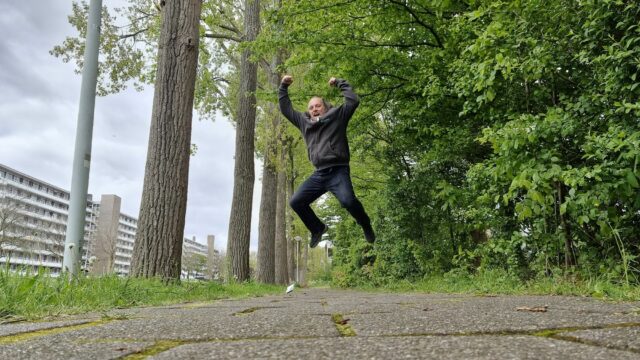
FP awarded in part for the lovely cache but mostly for the attentive CO who posted a note so promptly. TFTC!
This checkin to GCA1JJ5 Gemaal Mercatorstraat reflects a geocaching.com log entry. See more of Dan's cache logs.
My work colleagues from around the world have gathered for a meeting at a hotel near here. I woke a little early this morning and so I decided to come out and try to find a couple of geocaches before our team meeting starts.
After failing to find nearby GCA7Q4A “Elephant Parade” owing to construction work, I was hopeful of a find here. The coordinates put me exactly on top of a likely hiding place, and with a little exploration (and some pretending to tie my shoes!) I had the cache in my hand. SL, TFTC.
Listened for water pumping but couldn’t hear any over the traffic noise, I’m afraid! Greetings from Oxfordshire, UK.
I’m in Amsterdam for a meetup for my new team at Automattic.
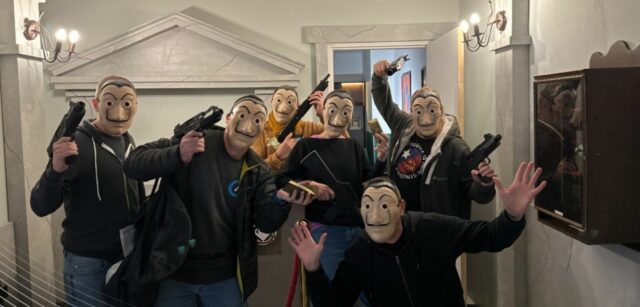
When we’ve not been out tackling escape rooms, finding geocaches, and eating curry, we’ve been doing a variety of activities to help solidify our new team’s goals, priorities, and expertise: y’know, the normal things you might expect on a company away week.
I volunteered to lead the initial session on our first day with a couple of icebreaker games, which went well enough that I’m inclined to share them here in case they’re of any use to you. The games we played are called Heraldry and Compairs. Let’s take a look:
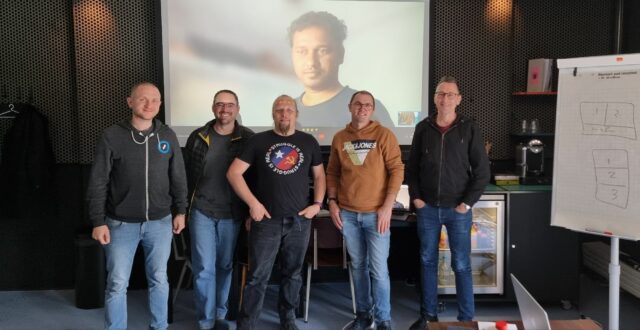
I was looking at the coat of arms of Noord Holland, the province in which Amsterdam lies, and thinking about all the symbolism and propaganda that’s encoded into traditional heraldry, and how much effort it takes to decode it… unless you just, y’know, guess!
I asked each participant to divide a shield into five quadrants and draw their own coats of arms, featuring aspects of (a) their work life, (b) their personal life, (c) something they value, (d) something they’re good at, and (e) something surprising or unusual. I really wanted to keep the time pressure on and not allow anybody to overthink things, so I set a 5-minute timer from the moment everybody had finished drawing their shield outline.
Then, everybody passed their drawing to the right, and each person in turn tried, as best they could, to introduce the person to their left by attempting to interpret their neighbour’s drawing. The known categories helped to make it easier by helping people latch onto something to start talking about, but also more-challenging as people second-guessed themselves (“no, wait, maybe it’s sailing you’re good at and guitar you play in your personal life?”).
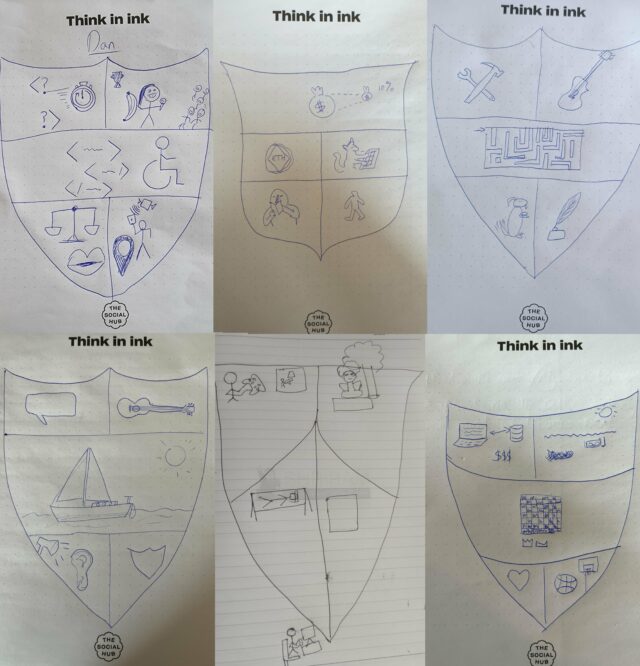
After each introduction is made, the person being introduced gets to explain their heraldry for themselves, congratulating their introducer on the things they got right and their close-guesses along the way.
It’s sort-of halfway between “introduce your neighbour” and “pictionary”. And it worked well to get us warmed-up, feeling a little silly, knowing one another slightly better, and in a space in which everybody had been expected to have spoken and to have made a harmless mistake (everybody managed to partially-interpret a shield correctly). A useful place to be at the end of an icebreaker exercise is left with the reminder that we are, after all, only human.
Next up, we played a game only slightly inspired by witnessing a game of Mr and Mrs the other week3. I threw together a Perchance (which, in the nature of such things, is entirely open-source and you’re welcome to adapt it for your own use) that generated a series of randomly-selected pairs of teammates and asked a question to differentiate the two of them.

Participants other than the two shown on the screen were challenged to guess the answer to the question. Sometimes the questions would have a definitive answer, and sometimes not: the joy was in the speculation! “Hmm, I know that Dan’s done quite a bit of globetrotting… but could he actually have travelled further East than a colleague who lives much further East than him?”
After a few seconds to a minute, once their colleagues had settled on an answer, the people listed on the question were encouraged to make their own guesses. Usually they’ll have a better idea as they are one of the data points, but that’s not always true!
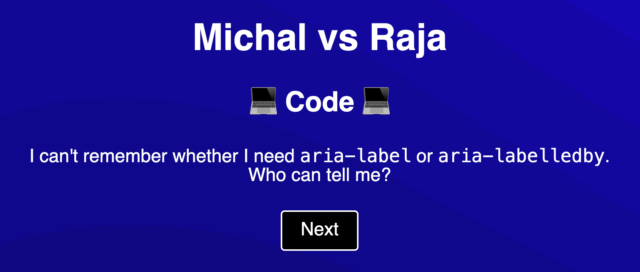
There’s no points, and you can play for as long as you like so long as it’s long enough that everybody gets at least one turn, so it’s a good “fill the rest of the time slot” game. It follows Heraldry moderately well as an icebreaker double-feature because the former is firstly about learning things about one another (and to a lesser extent guessing), and the latter is about the opposite.
I came out of both games knowing more about the humans behind the screens in my new team, and it seemed to open up the room for some good discussions afterwards, so the social lubricant effect was clearly effective too. If you give them a go or adapt them into anything else, let me know!
1 Our absent colleague instead had to tower over us on an enormous projector screen.
2 The red (“gules”) upright (“rampant”) lion in the coat of arms possibly comes from the heraldry of the city of Gelderen in Germany, but once part of the Dutch Republic. The lions striding (“passant”) to the left (“to dexter”) but turning to face you (“guardant”) come from the arms of Fryslân (Friesland), and its rectangles represent the districts of Fryslân. Aren’t you glad you asked.
3 Also known as The Newlyweds Game after the US game show of that name and basically the same format, Mr and Mrs is a game in which a (typically newly) married couple are asked questions about one another and their lives together which they answer separately and then those answers are compared. This induces a reaction of compersion when they’re “right” and in-sync and when the couple disagree it results in amusement. Or possibly divorce.
This checkin to GCA7Q4A Elephant Parade reflects a geocaching.com log entry. See more of Dan's cache logs.
Finding the elephant and the numbers was easy.
But some construction is happening at the GZ and I couldn’t see a safe/permitted way to get close. 😢